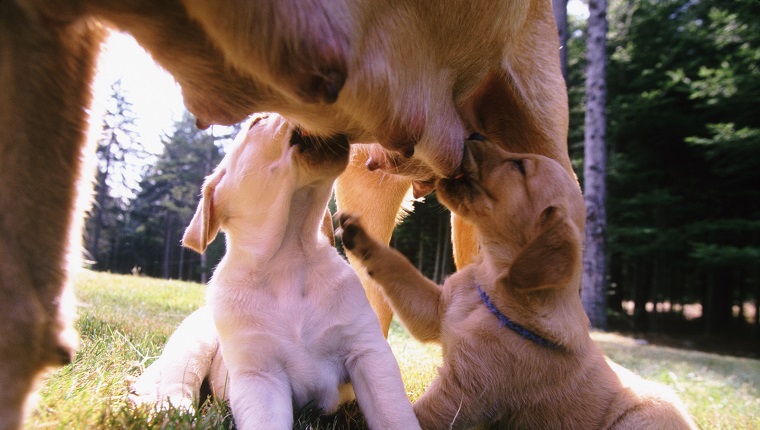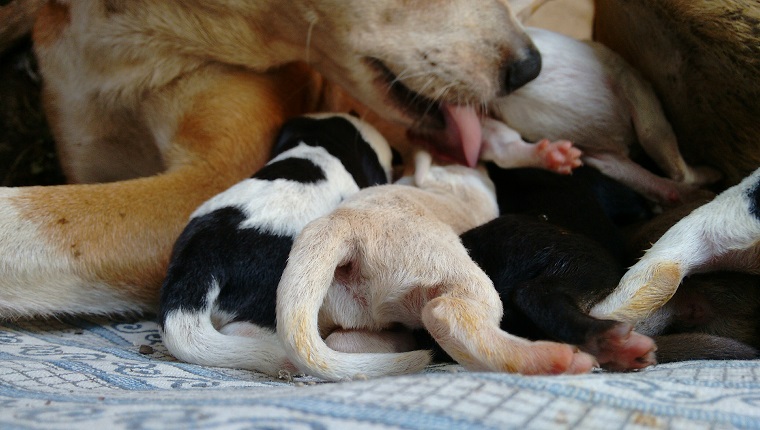Mastitis in dogs is an inflammation of the mammary glands in the breast that produce milk, usually due to bacterial infection. It’s mainly found in nursing dogs, though it’s sometimes found in females who aren’t nursing or pregnant and even some male dogs.
There are two types of mastitis in dogs. Galactostasis, also known as caked breasts, is a type of mastitis that affects dogs in late stages of pregnancy. Milk can accumulate and distend the teats, causing pain, though there’s no infection and the dog will not show signs of illness.
Acute septic mastitis is the other type and happens when bacteria enter the mammary gland and cause an infection or abscess. It can be fatal if it goes untreated.
If you see the signs of mastitis in your dog, it’s important that you consult your veterinarian right away so you can form a treatment plan. Here’s what you should know about the symptoms, causes, and treatments for mastitis in dogs.
Symptoms Of Mastitis In Dogs

The symptoms of mastitis in dogs are often visible around the teats, and dogs are likely to show signs of discomfort or pain.
If you notice any signs of mastitis in your dog, get to a vet right away, as an infection can spread quickly and cause major illness or become deadly.
Here are a few symptoms you might see in dogs who suffer from mastitis:
- Firm, swollen, or painful mammary glands
- Pus or discharge from the teats
- Discoloration of the teats
- Avoiding nursing puppies or growling and snapping at them
- Puppies lacking nutrition
- Lethargy
- Dehydration
- Weight loss
- Crying
- Fever
- Eventually septic shock, gangrene, or abscesses if left untreated
Causes Of Mastitis In Dogs

The common bacterial causes of mastitis in dogs usually include E. coli, staph, or streptococci. These bacteria are able to enter the mammary glands through injury to the nipples, often caused by cracking or scratches from puppies’ nails or teeth.
Dogs who have had mastitis in the past are more likely to develop it again in the future.
In cases where dogs are not pregnant or nursing, mastitis can be a secondary infection that migrates from some other place in the body, or it can be a symptom of mammary gland cancer.
You must see your vet if you notice symptoms of mastitis in your dog so you can get a proper diagnosis and treatment.
Treatment For Mastitis In Dogs

Treatment for mastitis in dogs often depends on the type and severity of the condition.
Galactostasis treatment usually involves withholding water for six to ten hours and withholding food for 24 hours. You may need to limit feeding after that for a period of about three days. A vet may also prescribe a diuretic.
Treatment for acute septic mastitis will likely include antibiotics. This may mean that any puppies will not be allowed to nurse from the affected teat and may need to be given supplementary nutrition.
The vet might also recommend applying a warm compress the affected area, and the gland may be milked to keep the ducts clear and reduce pain. A cabbage wrap may reduce swelling and promote faster healing.
In severe cases, a vet may drain or surgically lance the glands or completely remove them. Surgical removal is the usual course of action if the gland is abscessed or gangrenous.
If there’s an underlying cause, such as mammary cancer, the vet will discuss other courses of action for treatment.
Has your dog ever suffered from mastitis? How did your vet treat it? Let us know in the comments below!





